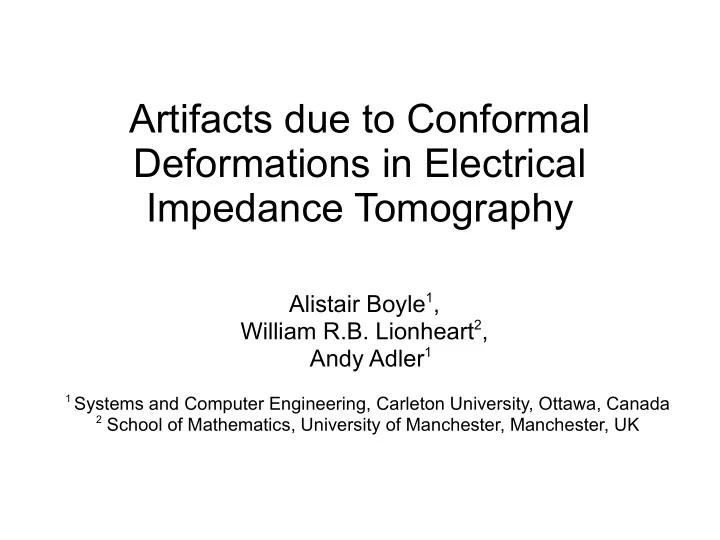

Artifacts due to Conformal Deformations in Electrical Impedance Tomography Alistair Boyle 1 , William R.B. Lionheart 2 , Andy Adler 1 1 Systems and Computer Engineering, Carleton University, Ottawa, Canada 2 School of Mathematics, University of Manchester, Manchester, UK
Boundary Movement For difference EIT, errors in the boundary cause significant artifacts. With chest EIT, breathing results in continuous changes in the boundary Uncorrected shape. (Boyle, et al 2008 ”Evaluating Deformation Corrections in Electrical Impedance Tomography”, EIT Conference 2008)
Anisotropic Changes ● Some boundary changes, upon reconstruction, result in anisotropic conductivities: – theoretically, for an infinite number of electrodes, non-conformal changes in boundary shapes and electrode locations can be uniquely determined (Lionheart,1998); – in some cases, conductivity and shape changes can be recovered using a combined image reconstruction model of both conductivity and shape changes (Soleimani et al, 2006).
Anisotropic Changes ● Some boundary changes, upon reconstruction, result in anisotropic conductivities: – theoretically, for an infinite number of electrodes, non-conformal changes in boundary shapes and electrode locations can be uniquely determined (Lionheart,1998); – in some cases, conductivity and shape changes can be recovered using a combined image reconstruction model of both conductivity and shape changes (Soleimani et al, 2006).
Conformal Deformations (two dimensions) ● A deformation that locally preserves the angles between vectors. ● Four types: – translation, – rotation, rotation translation – dilation, and – inversion/reflection. dilation “special”
Examples z az b cz d ,ad − bc ≠ 0 Möbius 2 z z a z Our “special” example =z(1+az) z = x 1 i x 2 x 1 X 1 i x 2 X 2 where
Conformal Deformations ● Conformal deformations (and only conformal deformations) do NOT result in anisotropic conductivity artifacts since they have locally preserved the angles through the deformation.
Examples Non-Conformal Conformal source without correction (Boyle, et al 2008 ”Evaluating Deformation Corrections in Electrical Impedance Tomography”, EIT Conference 2008)
Examples Non-Conformal Conformal source without correction (Boyle, et al 2008 ”Evaluating Deformation Corrections in Electrical Impedance Tomography”, EIT Conference 2008)
In EIT governing equation for a conformal deformation the conductivities match before and after: where c is for conductivity change and m is for conformal motion
A Bit of Math...
A Bit of Math...
For a Given Conformal Deformation ● Satisfy the Cauchy-Riemann equations: X = X 1 i X 2 where “the motion” x = x 1 i x 2 where “the basis”, ie: x and y axis ∂ X 1 ∂ X 2 ∂ X 1 −∂ X 2 = 0 = 0 ∂ x 2 ∂ x 1 ∂ x 1 ∂ x 2
A Bit of Math...
A Bit of Math... Substituting and taking the inverse...
In EIT (given same boundary measurements) 1 c = 2 m 2 B A where c is for conductivity change and m is for conformal motion
In EIT (given same boundary measurements) 1 c = 2 m 2 B A where c is for conductivity change and m is for conformal motion
In EIT (given same boundary measurements) 1 c = 2 m 2 B A where c is for conductivity change and m is for conformal motion
Example 1 c = 2 m , c = 1 2 / 2 z z z 2 B A
Discussion ● Conformal changes don't cause anisotropic conductivities and, thus can't be reconstructed from measurements alone. ● Can apply a better understanding of conformal motions to the reconstruction algorithms: – remove the conformal component when analyzing performance, or – choose appropriate conformal motion if selecting desired “artifacts” in a difference image
Thank you. Questions? Acknowledgement: This work was supported by a grant from NSERC Canada.
Recommend
More recommend